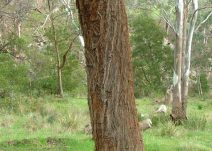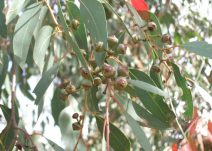Description
Tree, 20-35m high. Grey to red brown roughly fissured fibrous bark to the small branches.
Foliage
Dark green, sub-glossy leaves, 10-16cm long. Dense compact canopy.
Leaf veins obvious. Juvenile leaves opposite and rounded, then alternate in the adult leaves.
Flowers
White – cream flowers profusely in mid Summer to early Winter. Buds have 6-12 per cluster.
Fruits Large, with domed top, usually with 3 projecting sharp valves.
Habitat
Hills and slopes on poor shallow soils.Locally widespread on poor, shallow soils in low to moderate rainfall zones.
Special Notes
Often occurs with box and peppermint. Useful shade tree due to dense canopy and suitability for harsh exposed hilltops. Tolerates frost and drought.
Value to Wildlife
Bark used for nesting material for birds and mammals. Flowers are important nectar source for birds, gliders, moths, butterflies and insects. Attracts seed and insect eating birds. Occasional feed-tree for Koalas.


